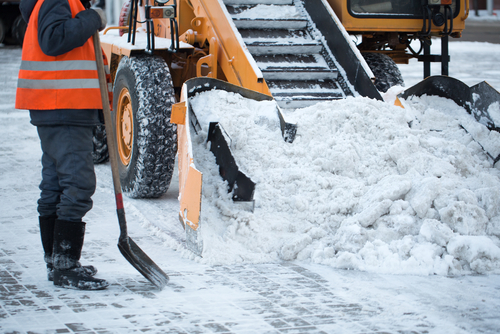Winter will be here before we know it, which means snow and ice for much of the northern United States. However, there could be snow even down South, so no matter where you live, it’s important that your facility be ready for winter weather.

BrightView, a commercial landscaping and snow services company, recently hosted an on-demand webinar entitled “Ready, Set, Snow: Best Practices for a Stress-Free Snow Season,” featuring four winter weather experts from the company. Here are some key takeaways from the event.
What Chemicals Should You Use?
Facilities professionals who decide to use their own staff for snow and ice removal should consider the advantages and disadvantages of various chemicals.
The most effective chemicals include:
- Sodium chloride (rock salt)—This is the cheapest option, but it’s not safe for pets. It’s most commonly used on roads and parking lots, but it’s not recommended for parking garages, and it’s most effective when the temperature does not go below 15 to 20 degrees Fahrenheit. It can also be used as a de-icer and an anti-icer, which means it can be applied before precipitation falls to prevent ice from freezing to asphalt, and in colder rural areas, it can be mixed with calcium or magnesium before or during spraying.
- Calcium chloride/magnesium chloride—This combines with moisture from the air or precipitation to create heat that begins snow and ice melting. This chemical is most effective at lower temperatures in locations where it could go down to negative 15 to 25 degrees Fahrenheit. While it is safer for pets, it leaves a white chalky residue on walkways and can be tracked into buildings, increasing the chance of indoor falls. Facilities professionals should be aware that more falls will happen on tile surfaces.
- Liquid brine (water and sodium chloride)—This can be used for pretreatment on roads up to 3 days before a winter weather event, but it will not work during freezing rain or when pavement temperatures drop below 20 degrees Fahrenheit. It will also not prevent accumulations caused by moderate or heavy winter storms, and it’s not plant-friendly.
- Non-chloride potassium format—This is intended for building entrances at the end of a winter storm. It can be used for temperatures as cold as negative 63 degrees Fahrenheit, is biodegradable, and doesn’t harm plants or animals. It also prevents the tracking of chemicals inside facilities.
Both facilities professionals and snow-removal providers should be cautious of slip and fall accidents. BrightView Director of Operations Dustin Stewart said that “over 25,000 slip and falls occur every day and slip and fall accidents do account for 15 percent of all work-related accidents,” adding the importance of winter weather safety, chemical application, and keeping facilities safe.
Choosing a Provider
Facilities managers who want to hire a snow-removal provider should do their research. It is important to ensure that providers require driver safety checks, have a dedicated safety champion at each location, and have ongoing safety training, including a safety orientation for new hires. Providers should also have certifications for power equipment use and properly use personal protective equipment (PPE).
Snow-Removal Contracts
Additionally, facilities managers should consider the most common types of snow-removal contracts, which include:
- Time and materials—There are hourly rates for labor, each type of equipment, and ice-melting chemicals, and you get what you pay for. These types of contracts are common in the mid-Atlantic and the South, where there are variable snowfalls.
- Per event—Certified snowfall increments—usually in 2-inch categories—have set charges that include a chemical application and a clearing, but pretreatment can be added. These are cheaper for long-duration storms with small snow totals.
- Fixed fee—These contracts have a fixed cost to remove winter precipitation for the season; the typical minimum is 3 years, and they’re great for budgeting purposes. Tiered pricing is also available for categories such as below-average, average, or above-average snowfall totals. They’re popular in the mid-Atlantic on properties with lots of asphalt.
However, Michael Holland, key account manager at BrightView, warned about the possible issues that could arise when entering into a contract. He explained that clients could question the time and material associated with a winter storm they were billed for and may feel they need to go to the site during the next storm, even if it’s at 2 a.m., to ensure they are getting their money’s worth. “Snow is emotional. It is more probable where a client and contractor can get into a contentious relationship,” he said.
To help eliminate possible contention, facilities professionals should ensure they are working with a reputable snow-removal provider so they can jointly create a customized snow management plan that would include 24/7 storm monitoring; detailed property mapping; and preseason planning, site inspections, and pre-storm preparation.
Communication
Communication is key before, during, and after a winter weather event. Facilities professionals should communicate with their own staff or a snow-removal provider 72 hours before a storm about the projected accumulation, how it would or should impact operations (keep in mind facilities like hospitals that must be open and accessible 24/7), and the response, which would include pretreatment options and cleanup. Based on updated weather forecasts, plans should be updated 24, 12, 8, and 4 hours before the storm, and the safety of personnel and on-site customers should take precedence. After storm cleanup, watch for icy spots, and move snow piles, if necessary.
Facilities professionals should ensure they plan now for snow and ice removal, whether they hire a snow-removal provider or do the work themselves. Proper training on equipment is also necessary. To watch the webinar, click here.
